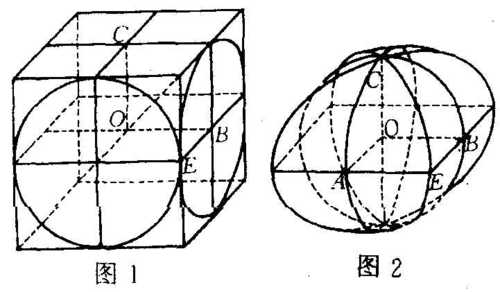An Ancient Chinese Puzzle
 The
Mou He Fang Gai
is a solid formed by the intersection of two perpendicular cylinders. In the 3rd century,
Liu Hui
found the volumetric ratio of the
Mou He Fang Gai
to the sphere. Can you?
The
Mou He Fang Gai
is a solid formed by the intersection of two perpendicular cylinders. In the 3rd century,
Liu Hui
found the volumetric ratio of the
Mou He Fang Gai
to the sphere. Can you?
The answer is 1.273239.
This section requires Javascript.
You are seeing this because something didn't load right. We suggest you, (a) try
refreshing the page, (b) enabling javascript if it is disabled on your browser and,
finally, (c)
loading the
non-javascript version of this page
. We're sorry about the hassle.
4 solutions
Exactly how I did it! (I knew about Cavalieri, but not about Liu Hui.)
I have used co-ordinate geometry to tackle this problem. I have assumed two cylinders with the equations x 2 + y 2 ≤ r 2 a n d y 2 + z 2 ≤ r 2 representing cylinders with axis along the z -direction and x -direction respectively. We have to find the volume of the resultant figure.
As we do in the case of sphere we assume it to be composed of infinite non circular disks of infintesimal thickness.
So at co-ordinate z we have a thin non-circular disk of thickness dz and the shape of the disk is as shown in the figure.
 Image
Image
k = r 2 − z 2
d V = a r e a ( s h a d e d r e g i o n ) d z
A r e a s h a d e d r e g i o n = 2 a r e a ( s e c t o r B O D ) + 4 a r e a ( B E O )
= 2 × O E × O B + 2 r 2 cos − 1 O B B E
d V = 2 ( z r 2 − z 2 + r 2 cos − 1 r z ) d z
V = 2 ( ∫ 0 r d V ) = 4 ( ∫ 0 r z r 2 − z 2 + r 2 cos − 1 r z d z )
Solving V f i g u r e = 3 1 6 r 3
also V s p h e r e = 3 4 π r 3 so our volumetric ratio is :
V S p h e r e V F i g u r e = π 4
Great job! You tackled this problem with calculus. However, there is a quicker solution involving Cavalieri's Principle. In fact, the Chinese mathematician Liu Hui in the 3rd century showed this exact ratio by noting that each cross-section is a circle inscribed in a square!
But I had no knowledge about Cavalieri's Principle. I just know simple calculus
Log in to reply
Cavalieri's Principle is more basic than calculus. Consider it proto-calculus. But these days, the application of Cavalieri's theorem is found in graphics softwares involving contractions and shifts.
Log in to reply
Interesting. Can you give examples of how graphics software use this principle?
Log in to reply
@Calvin Lin – https://php.radford.edu/~ejmt/eJMT_v6n1p5.pdf
Here's a link about how Cavalieri's theorem can be used for teaching. Although this paper is not a formal exposition of the practical applications used in graphics, it does capture the essence of preserving areas and volumes during contractions and distortions.
Good work guys! Tell your friends about this problem.
I performed this problem as student in the tedious way but the straight forward method is the one mentioned above by Steven Zheng .
Indeed years later I found this problem on the front cover of Martin Gadner Book its title is " The Unexpected Hanging and Other Mathematical Diversions " I bought it and saw inside it was solved in the same fashion that the one by the Chinese mathematician.
Nice! Ancient mathematicians thought of many calculus ideas, what Newton and Leibniz did was generalize the method with good notation (Leibniz being the mainstream for intuitiveness).
using the prismoidal formula: V = L/6 * (A1 + 4Am + A2). Lenght will be twice the radius of the cylinder. A1 is the area at point C, Am is the area at horizontal plane O which the square of 2R. and A2 is the area at the bottom point. therefore, V = (2R/6) * [ 0 + 4(2R)^2 + 0 ] = 16/3 R^3. finding its ratio from the volume of a sphere which is 4/3 pi*R^3, will give the ratio 4/pi or 1.273
Interesting approach! I actually noticed that too sometime earlier this year, after I proved that the prismoid formula only works if the curve is bounded by a continuous curve. This can be shown via Simpson's rule of numeric integration.
There is a quick solution involving Cavalieri's Principle. In fact, the Chinese mathematician Liu Hui in the 3rd century showed this exact ratio by noting that each cross-section is a circle inscribed in a square! Hence the ratio of the bulk solid follows 4/pi.